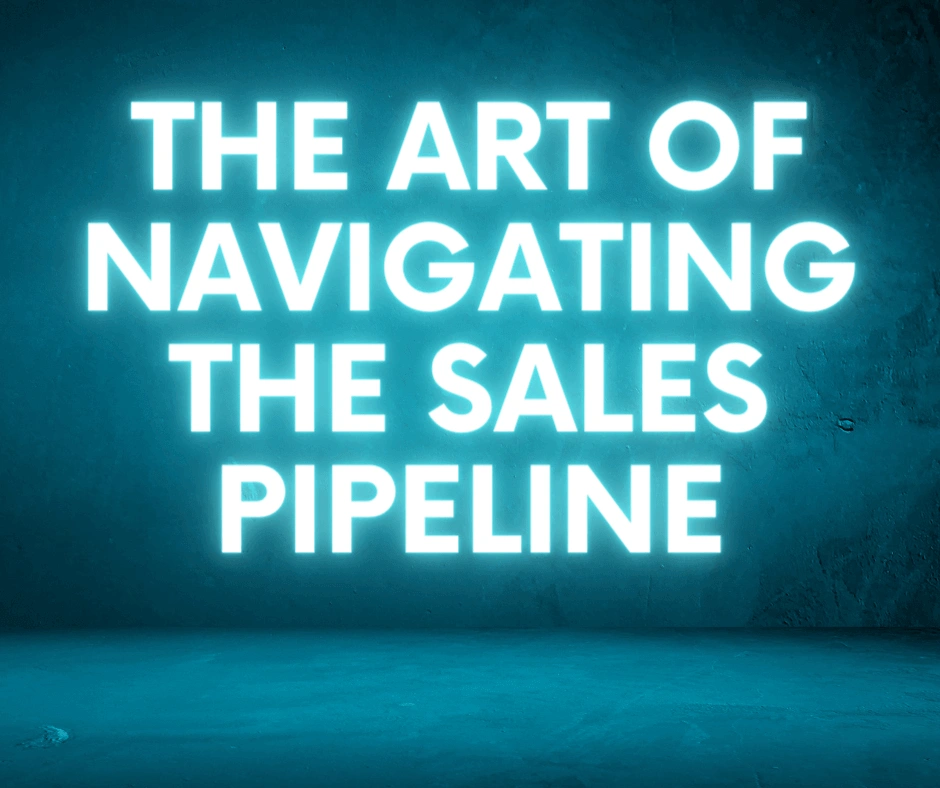
The Art of Navigating the Sales Pipeline: A Comprehensive Guide
 Abe Dearmer
Abe Dearmer

Apr 06, 2023
∙
9 min read

Sales
Master the art of sales pipeline management with this comprehensive guide, covering essential strategies and techniques to optimize your sales process. Learn how to navigate the sales pipeline, measure performance, and improve your sales team's performance.
Key Takeaways:
- Understand the stages of the sales pipeline and their importance in driving revenue.
- Establish a solid sales process that aligns with the buyer's journey.
- Monitor key performance indicators (KPIs) to make data-driven decisions.
- Implement effective pipeline management strategies, such as lead scoring and leveraging technology.
- Improve your sales team's performance through goal-setting, training, and collaboration.
Table of Contents
Introduction
In today's hyper-competitive business environment, mastering sales pipeline management is paramount to success. An efficient and well-managed sales pipeline has a significant impact on a company's revenue and growth. By understanding the intricacies of the sales pipeline, sales teams can effectively manage leads, close deals, and create long-lasting relationships with customers.
Understanding the Sales Pipeline
A sales pipeline represents the journey a potential customer takes from initial contact to a closed deal. It consists of key stages, each playing a vital role in securing a successful outcome. These stages include:
Lead Generation
This is the process of identifying and attracting potential customers to your business. It may involve marketing campaigns, social media engagement, and networking events. The objective is to create awareness about your products or services and pique the interest of prospective clients.
Lead Nurturing
Once a lead is generated, it's essential to cultivate a relationship and foster trust. This stage involves providing valuable information, addressing concerns, and engaging in meaningful conversations that demonstrate your expertise and commitment to helping the prospect succeed.
Qualification
Not all leads are worth pursuing. During the qualification stage, sales teams evaluate the potential of each lead based on their needs, budget, and authority to make a purchasing decision. By focusing on high-quality leads, sales teams can optimize their resources and increase the likelihood of success.
Proposal
After qualifying a lead, it's time to present a tailored proposal that addresses the prospect's unique needs and challenges. A compelling proposal highlights the benefits of your solution, showcases your competitive edge, and provides a clear roadmap to achieving desired outcomes.
Closing
The closing stage is where sales teams secure a commitment from the prospect. This may involve negotiation, addressing final objections, and providing incentives to finalize the deal.
Post-sale Follow-up
After closing a deal, it's crucial to maintain and strengthen the relationship with the customer. This includes providing excellent customer service, addressing any issues that arise, and staying in touch to ensure their ongoing satisfaction.
Despite the clear stages, sales pipelines can be fraught with challenges, such as lack of organization, poor communication, and missed opportunities. By identifying and addressing these issues, sales teams can overcome obstacles and achieve greater success.
Establishing a Solid Sales Process
A well-defined sales process is essential for navigating the sales pipeline effectively. By following these steps, sales teams can establish a strong foundation for success:
Identifying and Defining Each Stage
Clarifying each stage of the pipeline ensures that all team members are aligned and working towards the same goals. This involves setting expectations, outlining responsibilities, and establishing criteria for moving leads from one stage to the next.
Aligning with the Buyer's Journey
The sales process should mirror the prospect's decision-making process, addressing their needs and concerns at each stage. By understanding and empathizing with the buyer's journey, sales teams can create a seamless and persuasive experience.
Adapting to Different Sales Cycles
Sales cycles can vary depending on the industry, product, or service. It's crucial for sales teams to recognize these differences and adjust their approach accordingly.
Continuous Improvement
A successful sales process evolves with time. Regularly reviewing and refining the process based on feedback, performance data, and market trends will ensure continued growth and success.
Measuring and Monitoring the Sales Pipeline
Effective sales pipeline management requires monitoring and measuring key performance indicators (KPIs) to identify areas of improvement and make data-driven decisions. Important KPIs include:
Conversion Rates
This metric tracks the percentage of leads that move from one stage to the next, providing insights into the effectiveness of sales tactics and strategies.
Average Deal Size
Understanding
the average deal size helps sales teams focus on opportunities with the greatest potential impact on revenue. By targeting larger deals or upselling existing clients, teams can maximize their efforts.
Sales Velocity
Sales velocity measures the speed at which leads move through the sales pipeline, indicating the efficiency of the sales process. Improving sales velocity may involve refining lead nurturing tactics, streamlining proposal development, or addressing bottlenecks.
Win Rate
The win rate is the percentage of deals closed successfully, providing insights into the overall effectiveness of the sales team. By monitoring the win rate, managers can identify areas of improvement and implement strategies to boost success.
Regular pipeline reviews are essential for maintaining an accurate and up-to-date understanding of the sales landscape. Data-driven decision-making allows sales teams to adapt to changing market conditions and continuously optimize their strategies.
Implementing Effective Pipeline Management Strategies
Sales pipeline management involves a combination of tactics and strategies designed to optimize performance. Key strategies include:
Prioritizing Leads with Lead Scoring
Lead scoring involves assigning a value to each lead based on factors such as engagement, company size, and purchasing potential. By prioritizing high-scoring leads, sales teams can focus their efforts on opportunities with the highest probability of success.
Regular Follow-ups and Nurturing
Consistent communication with leads is essential for building trust and keeping prospects engaged. By developing a structured follow-up schedule, sales teams can ensure that no opportunities are overlooked.
Managing Opportunities and Risks
Effective pipeline management involves identifying potential risks and addressing them proactively. This may include monitoring competitor activity, anticipating objections, and staying informed about industry trends.
Balancing Short-term and Long-term Goals
While immediate revenue is important, sales teams must also focus on nurturing relationships that may lead to long-term success. By balancing short-term and long-term objectives, teams can create a sustainable pipeline that supports ongoing growth.
Leveraging Technology and Automation
Customer relationship management (CRM) software and other sales automation tools can streamline the sales process and provide valuable insights. By embracing technology, sales teams can improve efficiency and enhance their ability to manage the sales pipeline effectively.
Improving Sales Team Performance
A high-performing sales team is crucial for successful pipeline management. Key strategies for improving team performance include:
Setting Clear Expectations and Goals
Establishing measurable objectives and benchmarks ensures that all team members understand their responsibilities and are working towards common goals.
Training and Coaching
Providing ongoing training and coaching helps sales teams stay current with industry trends, develop new skills, and refine their techniques.
Providing Feedback and Recognition
Regular feedback and recognition are essential for motivating sales teams and fostering a culture of continuous improvement.
Fostering Collaboration and Communication
Encouraging open communication and collaboration within the sales team can lead to creative problem-solving and a more cohesive approach to managing the sales pipeline.
Conclusion
In conclusion, effective sales pipeline management is a multifaceted process that requires a deep understanding of the sales journey, a well-defined sales process, and the ability to measure and monitor performance. By implementing effective strategies and continuously refining their approach, sales teams can navigate the sales pipeline with precision and achieve greater success.
Frequently Asked Questions
- How can I improve my sales pipeline management?
To improve your sales pipeline management, consider the following steps:
- Define a clear sales process that aligns with the buyer's journey
- Regularly review and refine your sales pipeline stages
- Implement lead scoring to prioritize high-quality leads
- Utilize technology, such as CRM software, to automate and streamline tasks
- Monitor key performance indicators (KPIs) and make data-driven decisions
- Provide ongoing training and coaching for your sales team
- Encourage collaboration and communication among team members
- What are the stages of a sales pipeline?
The stages of a sales pipeline typically include:
- Lead generation: Attracting potential customers through various marketing efforts
- Lead nurturing: Building relationships and trust with prospects by providing valuable information and addressing concerns
- Qualification: Evaluating the potential of each lead based on their needs, budget, and decision-making authority
- Proposal: Presenting a tailored solution that addresses the prospect's unique needs and challenges
- Closing: Securing a commitment from the prospect, which may involve negotiation and addressing final objections
- Post-sale follow-up: Maintaining and strengthening the relationship with the customer through excellent customer service and ongoing communication
- What KPIs should I track for my sales pipeline?
Important KPIs for your sales pipeline include:
- Conversion rates: The percentage of leads that progress from one stage to the next
- Average deal size: The average revenue generated by closed deals
- Sales velocity: The speed at which leads move through the sales pipeline
- Win rate: The percentage of deals closed successfully
Tracking these KPIs can provide valuable insights into the effectiveness of your sales process and help identify areas for improvement.
- How can I prioritize leads in my pipeline?
You can prioritize leads in your pipeline by implementing a lead scoring system. This involves assigning a value to each lead based on factors such as engagement, company size, and purchasing potential. By focusing on high-scoring leads, you can optimize your resources and increase the likelihood of success.
- How can technology help in managing my sales pipeline?
Technology, particularly customer relationship management (CRM) software, can play a significant role in managing your sales pipeline. CRM systems can help you:
- Organize and track leads at various stages of the pipeline
- Automate routine tasks such as follow-ups and lead nurturing
- Monitor key performance indicators (KPIs) and generate reports
- Provide a centralized platform for collaboration and communication among team members
- Integrate with other sales and marketing tools to create a cohesive and efficient sales process
By leveraging technology, sales teams can streamline their efforts, improve efficiency, and make more informed decisions.
Michael King says...
"I can’t think of a time where a client has requested something that we weren’t able to do with FiveCRM. Unlike most systems, it has a lot of flexibility."

Managing Director, Senior Response
JAINE HUSBANDS SAYS...
“Each client, and each of their campaigns, has its own unique specifications. We essentially needed to set up mini CRMs on one platform to meet those requirements.”

Operations Director, Team Marketing
Why wait?
Start improving your outbound efficiency now, with the most customizable Sales solution on the market.